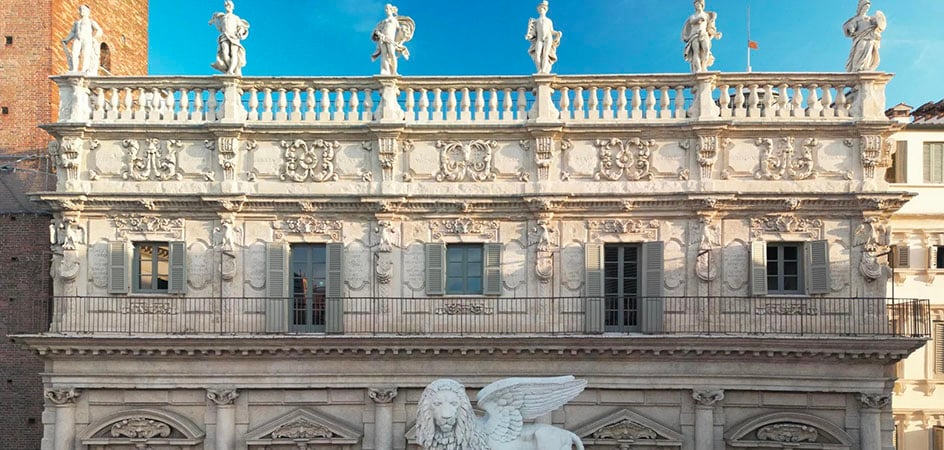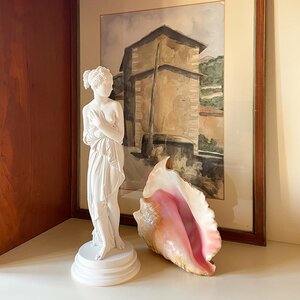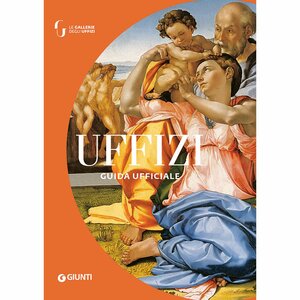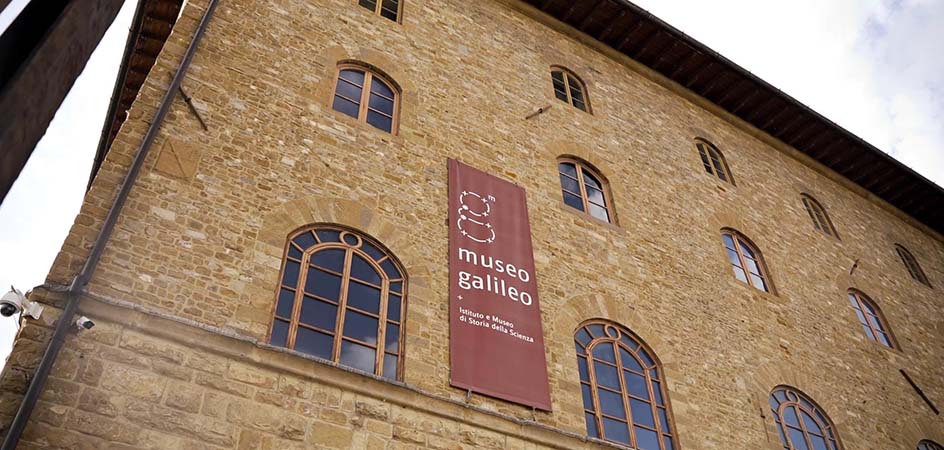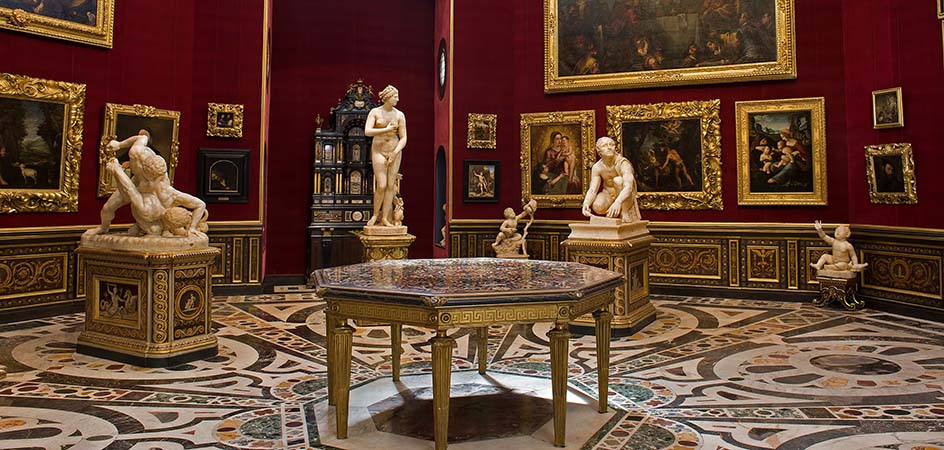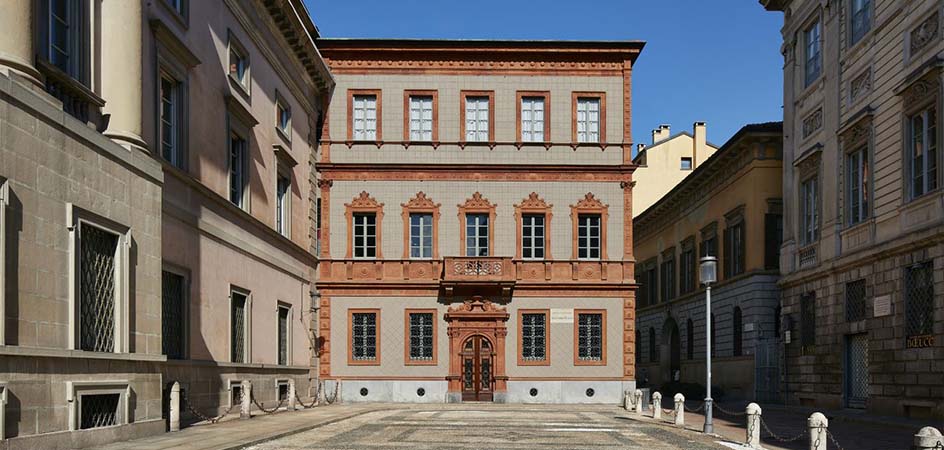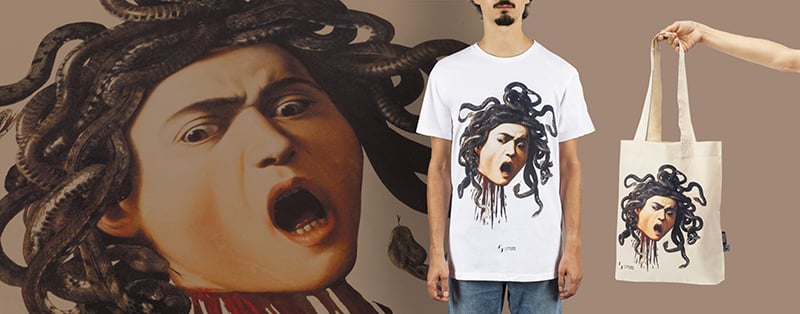Majestic and elegant, Palazzo Maffei stands like a theatrical backdrop at the end of the enchanting Piazza delle Erbe, in the heart of Verona. Its 17th-century façade, animated by lively Baroque decorations, introduces interiors filled with the treasures of Luigi Carlon’s collection. An entrepreneur and passionate collector, Carlon has transformed the ancient Maffei residence into a true contemporary Wunderkammer, where the ancient and the modern meet, revealing unexpected and evocative connections.

A boundless, kaleidoscopic collection
For years, Carlon kept in his bedroom a painting by Carlo Ferrari, known as il Ferrarin (1813–1871): a Veduta di piazza delle Erbe in which Palazzo Maffei stands out against the backdrop of the city’s everyday life. Almost a prefiguration of what would become the home of his vast art collection, previously kept within his private walls.
Since 2020, the Casa Museo Palazzo Maffei has welcomed visitors to explore the spirit of this refined collector through paintings, sculptures, and objects of applied art from different ages and regions. It is a unique spectacle, not only for the rarity of the artefacts displayed, but also for the originality of the display itself. Those expecting a chronological layout will be disappointed. The rigid sequential approach has been set aside: instead, the rooms follow thematic affinities, where masterpieces from distant eras engage in dialogue, suggesting powerful resonances and new impressions.
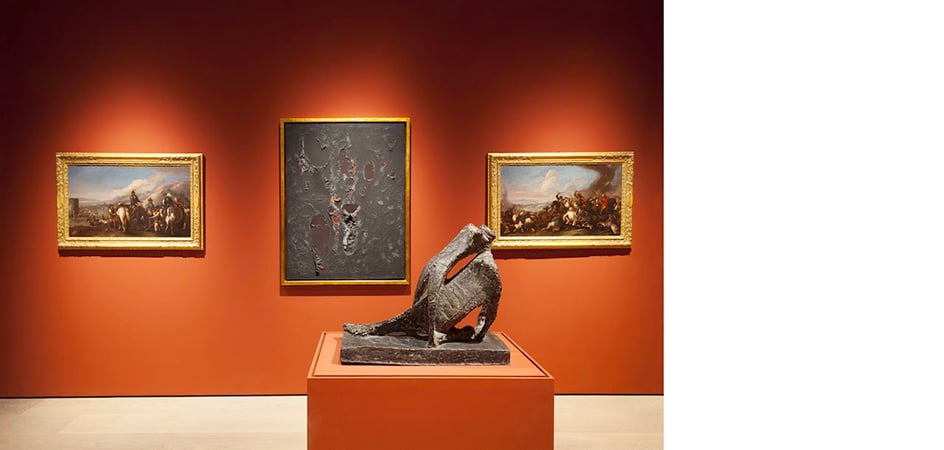
An Eclectic and Stimulating Display
Among the most striking combinations is Lucio Fontana’s Concetto spaziale (1964–1965) paired with the Crocifissione by the Second Master of San Zeno (c. 1320–1360). A bodily yet immaterial dimension connects the two works: a wounded canvas, like Christ’s wounded body; an “other” space opening in Fontana’s cuts and in the gilded background of the 14th-century triptych.
A more intimate link unites Arturo Martini’s white Maternità (1932–1933), a sculpture in Finale stone, with the Sacre Famiglie of the 14th and 15th centuries in the room dedicated to the Mater amorevolissima.
Of an entirely different tone is the “war room,” where the horrors of conflict are evoked literally and metaphorically — from battle scenes by Antonio Calza and Matteo Stom to Alberto Burri’s Tutto Nero from the Combustioni series (1957), and Piccolo miracolo by Marino Marini (1951).
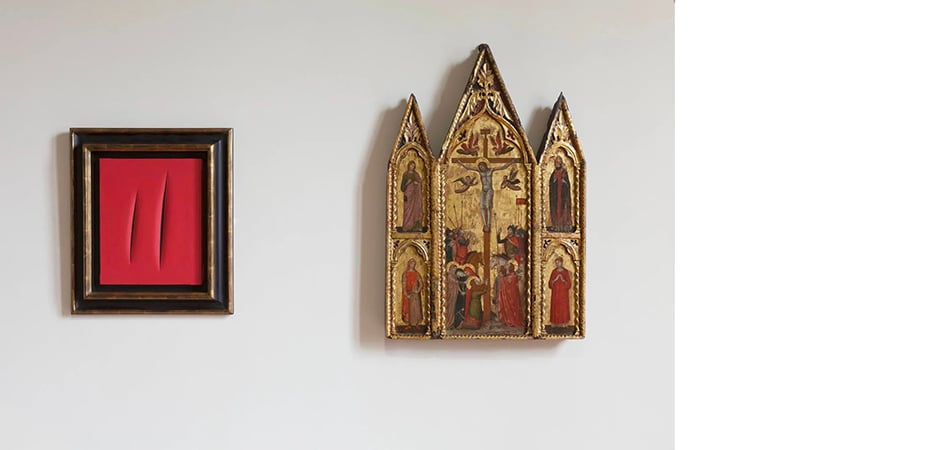
The exhibition also features fine craftsmanship and pieces of design, such as those brought together in the Salotto blu. Here, dark, refined wallpaper provides a backdrop for Chinese lacquered furniture, 19th-century decorative objects, and paintings from the American Avant-Garde. Indeed, the Historical Avant-Gardes are among the key protagonists of the Carlon Collection.
Highlights of Palazzo Maffei
An entire section of Palazzo Maffei is devoted to the 20th century and brings together all the leading figures of the Historical Avant-Gardes: Futurism, Dadaism, Metaphysical Art, Surrealism, and Magic Realism — as well as Pop Art, Arte Povera, Abstraction, and major independent artists such as Giorgio Morandi.
The collection includes everyone: from Giovanni Boldini to Mimmo Paladino, via René Magritte, Vassilij Kandinskij, Andy Warhol, Amedeo Modigliani, Joan Miró, and Max Ernst. Carlon’s interest in art — especially in that which innovates and disrupts — is unmistakable.
In a recent interview, he declared that the artist he could never part with is Picasso, precisely because of his constant capacity for reinvention. The Spanish master, father of Cubism, is represented by two paintings: Tête de femme (1943), portraying — with extreme formal synthesis — Dora Maar (1907–1997) — photographer, painter, poet, and Picasso’s companion between 1935 and 1943 — and Femme assise (1953), inspired by the artist Françoise Gilot (1921–2023), with whom he had a decade-long relationship and two children.

Carlon’s taste for provocation — an aspect dear to the collector — emerges in works such as Marcel Duchamp’s Boîte-en-Valise, which with subtle irony proposes a portable version of the museum. His “box in a suitcase” contains reproductions of his masterpieces, including the Fontana, L.H.O.O.Q., and the Portabottiglie: a multiplication of ready-mades alluding to the transience of life and art.

Verona and the introduction to the world of art
Equally rich is the section dedicated to Veronese painting. Indeed, the Carlon Collection began precisely with local artists of his time: the first painting he purchased, as a very young man with savings from his job at the bank, was Moulin Rouge by his friend Eugenio Degani, a Veronese painter.
It didn’t take long for his gaze to expand, also moving back in time: landscape painters were added, including Gaspare Vanvitelli, with his Veduta dell’Adige nei pressi di San Giorgio in Braida (1705). Then came Baroque painters such as Simone Brentana and Gregorio Lazzarini, whose monumental Strage degli innocenti (16th–17th century) and Mosè fa scaturire l’acqua dalla roccia can now be admired across entire walls — and further back, to the Trecento.
Are you interested in articles like this?
Sign up for the newsletter to receive updates and insights from BeCulture!
The most curious story, however, concerns a 16th-century painting, Il ratto di Elena by Zenone Veronese, acquired by the Metropolitan Museum of New York. During its restoration, it was discovered that the canvas was larger than it appeared — about 40 cm had been folded under the stretcher. A revelation for the new owner and the prestigious American museum, which would have gladly had it back.
A lifelong passion crowned at Palazzo Maffei

The Carlon Collection numbers over 650 works, gathered over more than fifty years. A passion born in his youth while leafing through Capolavori nei secoli — the encyclopaedia published by Fratelli Fabbri Editori, whose issues he still keeps in his cellar — and nourished year after year alongside his professional life.
Born in Verona in 1938, a young bank employee, he studied languages in the evenings to obtain his degree. After a brief period in Paris — where he flirted with a career in cinema — he returned to Italy and in 1978 founded Index, a company specialising in thermal and acoustic insulation materials. His waterproofing products, resistant to extreme temperatures, have been exported to more than a hundred countries and used to protect the Empire State Building in New York, the Petronas Towers in Kuala Lumpur, the Burj Al Arab in Dubai, the Parco della Musica in Rome, and the Pont de Normandie in France, to name just a few.
“I was for years the traveller with the highest mileage in the Alitalia Freccia Alata Club” Carlon once said in an interview. Yet this never prevented him from nurturing his profound love for art. So when the insurance company Generali put the building in Piazza delle Erbe up for auction, he did not let it slip away.
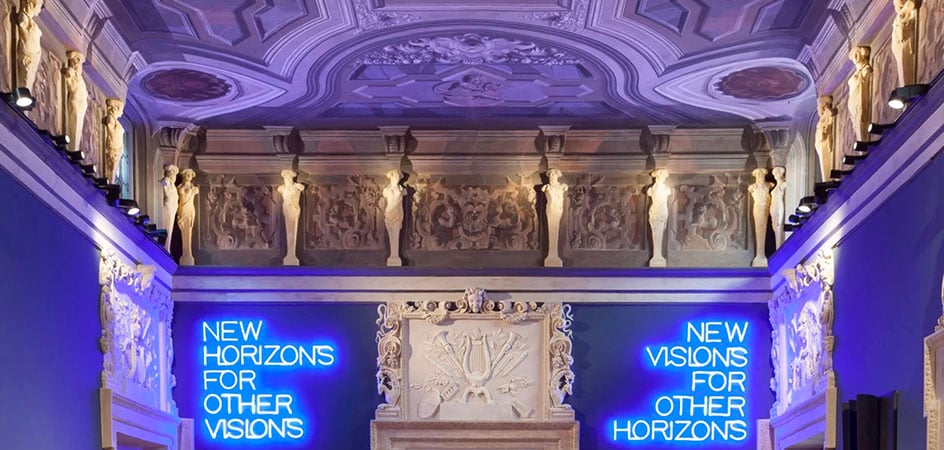
Completely renovated in the 17th century, Palazzo Maffei is one of the most elegant buildings in Verona — both in its Baroque façade and its frescoed interiors. Unmistakable outside is the balustrade crowned by the Olympian deities; unforgettable inside is the majestic helical staircase that spans the building’s full height. Frescoes, stuccoes, decorated ceilings, and a masterful restoration and exhibition design guide visitors through one of the most astonishing private collections of our time.


